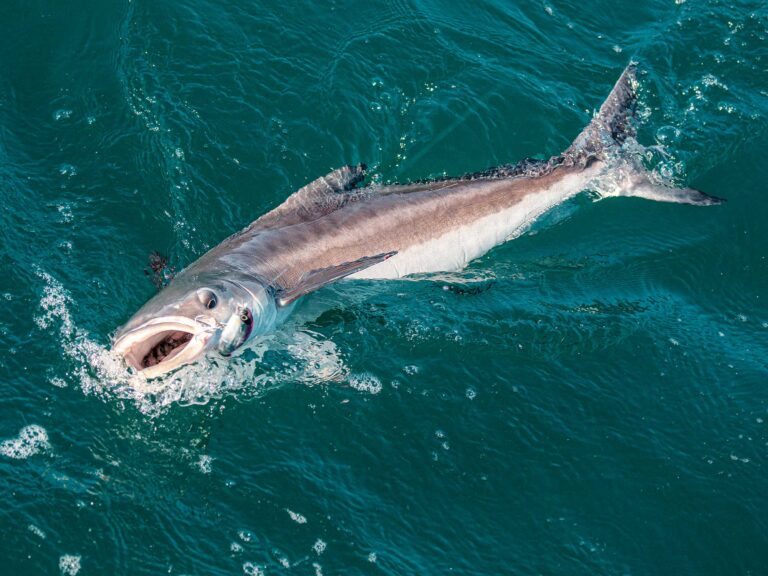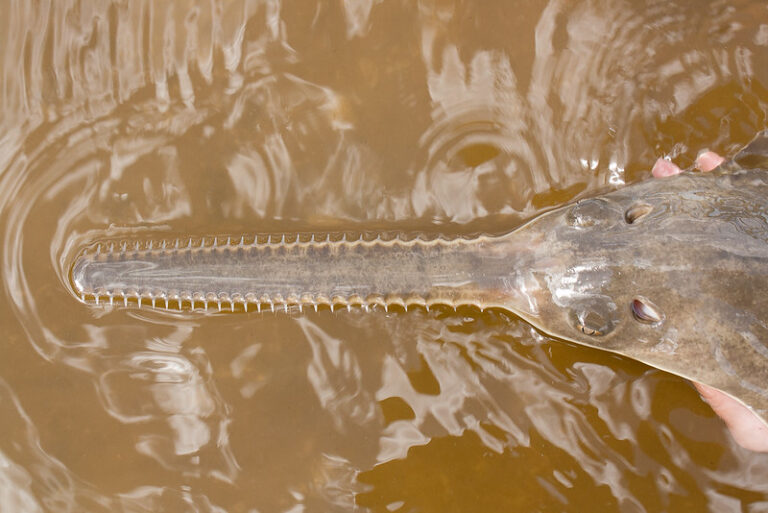
In 1976, Mike Barnes, a grade-school classmate and fishing buddy of mine, came up with the idea to build an aluminum box around a pair of fluorescent lights.
|| |—| |Juice Up Your Boat When using fishing lights it’s crucial to have a power source other than your boat battery. Bring at least one or two 12-volt batteries. I use 12-volt green fishing lights from the Fishinglights Company (www.fishinglights.com) in Houston, Texas. The fully-submersible, fluorescent-green lights have a high intensity and are built in 38- to 61-inch-long waterproof PVC housings. These lights can be bridled to hang horizontally off the boat, or just add weight to sink them vertically. I use a submersible 42-inch light off the stern and one 61-inch light on each side for maximum light. One 12-volt battery will power them all night. It’s smart to have some sort of illumination in the cockpit, such as a propane- or battery-powered lantern. With an elevated floodlight, the entire boat always has plenty of light. I also wear a headlamp when it’s time to re-rig. 1. Two submersible fluorescent-green 61″ 12-volt fishing lights – one off each side2. Submersible fluorescent-green 42″ 12-volt fishing lights off the sternEditor’s Note: Be sure to use only submersible lights designed for fishing. Other lights can result in dangerous electric shock. Photo: Bryon Thompson| It took a while to fabricate, but the finished product was a major success. The first night we hooked up the lights to a 12-volt battery was like a dream.
A clear, green tide was moving that evening when we anchored up along the Port O’Connor jetties. We rigged our rods for fishing live shrimp under slip corks. Nothing happened during the first hour, but then the night action lit up.
“Look at all those baitfish schooled up under the lights,” Barnes said. “Something’s got to move up to feed on them.”After a few minutes we could hear the sound of trout slurping shrimp and shad off the surface, right on the edge of where light and dark waters melded. Barnes and I flipped live shrimp into the current, and within just a few seconds solid trout snapped up our baits. In no time we had loaded up a cooler with fat jetty trout. We could hardly believe our luck: We didn’t have to put up with the afternoon heat of a hot Texas summer, and there wasn’t a single other boat that we had to contend with.
If there was any bad side to that night it was that Barnes and I had a bunch of trout cleaning ahead of us.
First Lights
Barnes and I certainly weren’t the first anglers along the Gulf Coast to catch trout under the lights. Pier fishermen had been doing it for years. But we were definitely among the first to rig fluorescent lights in a can and fish them along the jetties and rigs in the bays. Still, night fishing has come a long way since the ’70s.
These days it’s a rarity to head out and not see at least a few boats anchored with glowing lights, since tackle stores now stock their shelves with a variety of nightlights – green, yellow, white. Some fishermen swear that the green lights attract the most trout, while others say it’s just a matter of attracting the right baitfish needed to draw predatory trout. Thirty years ago anglers experimented with an assortment of lights and made hundreds of night-fishing trips out on the bays and along the jetties. They thought the trick was simply to produce light – and a lot of it at that. But anglers today know that catching specks at night isn’t that simple.
“A successful night of trout fishing under the lights requires a few things to be lined up,” says Barnes, who has been night fishing along the Gulf Coast for 30 years. “You’ve got to have current. That’s the most important thing. It usually doesn’t matter if it’s outgoing or incoming, just as long as it’s moving. Next you need baitfish circling under the lights. Third you need live bait to catch the trout on a regular basis. That’s especially true when the tide is sandy.”
When looking to ancfor a spot hor, Barnes has found that water clarity generally isn’t a factor. “I’ve caught trout in water so sandy you could almost walk on it,” he says. “That’s when live bait fished below a float is deadly. In clear water you can use both live or artificial baits.”
Once he’s found his spot, Barnes likes to have the bow of his boat pointed into the current, and to hold it steady he uses anchors at the bow and stern. First he positions his boat about a hundred feet upcurrent of where he plans to fish before he drops the bow anchor. Once that anchor takes hold, he feeds out line until the boat is in place. Lastly, he drops the anchor off the stern to keep the boat from sliding in the current. “If the lights are going back and forth, the baitfish will be spooked and so will the trout,” he says. “If possible, you want to keep the boat in one spot.”
Night Rider
One of the most successful night-fishing boats on the entire Gulf Coast is the Night Stalker Too on Lake Calcasieu in southwest Louisiana out of the Hackberry Rod & Gun Club (HR&GC;). Over the past few years this outfit has run some of the most successful night-fishing trips I’ve ever seen along the Gulf Coast. “We started out with one boat, now we have two,” says Captain Buddy Oakes, with HR&GC.; “For fishermen that want to beat the heat of summer along the Gulf Coast, fishing under the lights is the only way to fly.”
|| |—| |Who To Contact Hackberry Rod & Gun Club Hackberry, Louisiana (337) 762×3391 www.hackberryrodandgun.comThe Fishinglights Company Houston, Texas (713) 398-7613 www.fishinglights.com| The boats out of HR&GC; aren’t exactly what you would call ordinary. The Night Stalker Too is 44 feet long and 16 feet wide. Each boat is air-conditioned, has a television and VCR, a bathroom, a kitchen, a barbeque grill and comfortable bunks. Most important, however, the boats have six 1,500-watt lights powered by two generators.
“The white lights seem to work best,” says Kirk Stansel, who co-owns and operates HR&GC; with his brothers, Guy and Bobby. “They consistently draw more baitfish and trout.”
Along with knowing the right type of light to use, Stansel and his staff also understand that patience is a must when night fishing. “We anchor up, fire up the barbecue grill, put on the steaks and wait for the trout to start feeding,” says Captain Kevin Augustine, who runs the Night Stalker Too, adding that he prefers to fish shell reefs six to ten feet deep. “Sometimes it’s a quick-hit deal. On other nights, you’ll have to wait an hour or so for the action to start.”
Magic Depths
Regardless of the water depth you anchor in, trout generally don’t feed in water over ten feet deep because baitfish tend to stay inside the area that’s lit up. And even though you might be fishing in the right lane of the current, you won’t catch much if the depth is wrong. Make adjustments until you start getting bites since trout will almost always be feeding at a precise depth. For example, if you are fishing in six to seven feet of water, the magic depth is probably going to be four to five feet deep. You want to flip your live bait upcurrent and then slack-line it downcurrent. If nothing happens on a few drifts, fish another lane of water. A slip-float rig works best in these situations because it allows you to fish at any depth. This is an effective technique along the jetties where depths can range from three to 20 feet.
After you find the right depth, lure and bait selection usually depends on the conditions.
|| |—| |Safety Tips When fishing at night, the main thing is to know how to get from point A to point B in the dark. Running a boat at night can be confusing because there are all sorts of lights to contend with. And if you’re fishing at the jetties you’ll have to steer around ships coming into port and tugs pushing or pulling barges. Believe me, the lights can be very confusing. And poor conditions only make things worse. It’s best to keep your speed at a minimum and have at least two people on watch when running in the dark. If you are unfamiliar with what green, red and white lights mean, contact the U.S. Coast Guard Auxiliary or U.S. Power Squadron for information. Always keep your running lights on, even while you are fishing. – Robert Sloan| Nights when trout suddenly begin popping shrimp and shad on the surface usually occur in green to sandy-green water. This is a good time to use soft-plastic jigs, wobbling crankbaits or slow-moving plugs that imitate mullet. In some situations, especially when the water is holding a little sand, it’s best to use a soft-plastic that has a built in vibration like a Yum Samurai Shad in glow-pink or glow-chartreuse rigged on a 1/4-ounce leadhead jig. Over the past two years, Stansel said a three-inch paddletail Assassin has been a killer on the Night Stalker Too.
In really clear water you will have the most success with fast-moving jigs that dart up and down on an erratic retrieve, but make sure you fish clear-water baits with a loop knot for more action. In the past I have murdered trout at night on the upper Texas coast with an Excalibur Swim’n Image – a three-inch, 7/16-ounce tight-wobbling crankbait. On a steady retrieve it runs about two feet deep. The lure works well in almost any situation under the lights, and I’ve found that the speckled-trout and striped-mullet color patterns produce the most fish. Retrieve speed depends on the clarity of the water: fish it slow in sandy water, fast in clear water or twitch it on the surface if the trout are feeding on top.
Under the lights you don’t have to suffer the summer heat or put up with crowds. In fact, on many nights you and your buddies will have the entire place to yourselves. Once you get on location, you just set up the lights, kick back and wait for the action to begin. And if the bait and trout take their time before they come to the lights, you can always do a little stargazing or take a nap.









